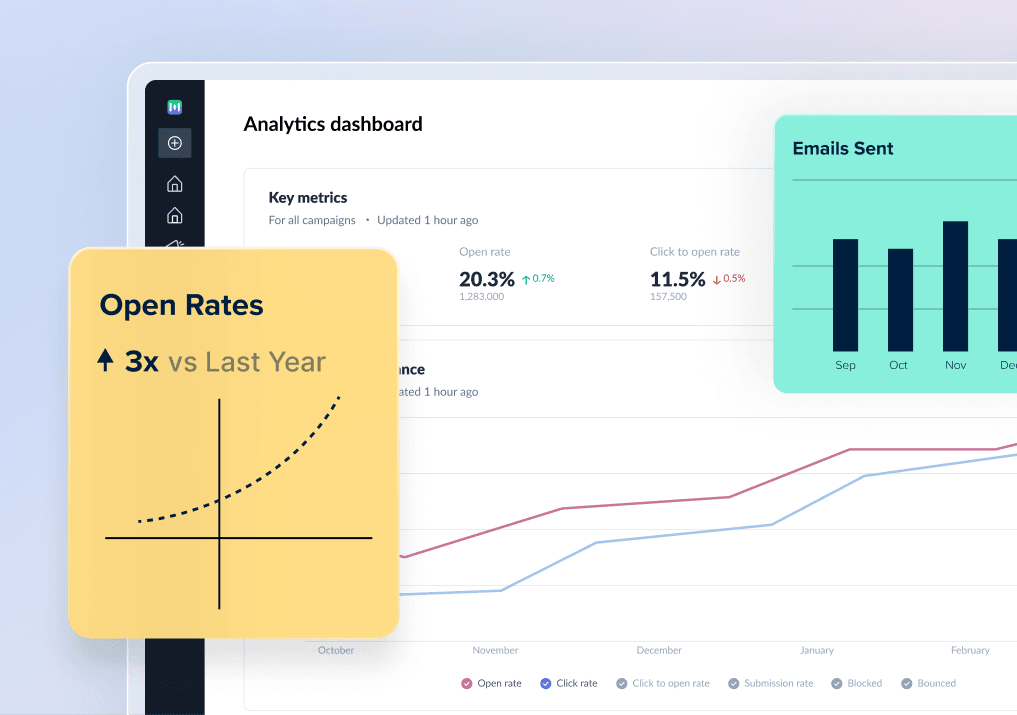As an email marketer, it’s crucial to maintain a healthy subscriber list. While it’s disappointing to see recipients opt out of your emails, it’s a natural process all marketers face. Opt-out email is essential as it helps you establish a solid relationship by maintaining respect for their preferences by ensuring that your communication is relevant. This guide will cover opt-out emails and how to prevent audience opt-outs.
Table of Contents
What is an Opt-out email?
The opt-out email is a communication tool in email marketing that allows recipients to indicate that they would like to unsubscribe from the email lists as their interests no longer align with the brand. This process is also known as unsubscribing, and the sender is legally obligated, as per the CAN-SPAM Act, to provide an opt-out link in every email that allows recipients to opt out for further communication easily.
The types of opt-out emails are as follows:
General opt-out emails : A subscriber requests to stop receiving all communications from that sender regardless of the content or purpose of the email.
Specific opt-out: It is when a subscriber wishes to opt out from a certain types of email from the sender.
Unsubscribe link: These are included in emails and offers a straightforward way to opt-out. You are led to a landing page , and provide opt-out.The goal is to remove the subscriber form the sending mail list.
The Importance of Respectful Communication
As an email marketer, you must maintain respectful communication from start to end. And one that has gained popularity over the years is opt-out emails because of its ethical approach.
Unsolicited emails can be perceived as intrusive and counterproductive, marking emails as spam or ignored.
Let’s cover in brief the importance of being respectful in email marketing:
1. Build trust through transparency.
Customers are concerned about how their data is used and value their privacy. You can help establish trust and foster positive customer relationships by demonstrating email transparency.
Ensure that you have proper privacy policies in place when they opt-in. This sets the tone for what kind of emails they can expect. Also, you can provide insights into personal data usage and personalize your emails based on your preferences.
Commit to keeping your subscribers informed regarding email marketing practices or any updates in data usage.
2. Mitigating Overwhelm: The Cost of Unwanted Emails
It can be overwhelming for recipients to receive unwanted emails, resulting in a cluttered inbox. When considering the cost of unwanted emails and their impact incorporating opt-out emails allows recipients to unsubscribe from future communications.
This is because opt-out emails allow subscribers to stop communications from the sender. While opt-out is a valuable feature for subscribers who do not wish to receive emails still important to recognize the impact it has on brands.
3. Allowing them to choose their preferences - user-friendly preference centers
By providing user-friendly preference centers, subscribers must choose their preferences. Reducing email overwhelm and maintaining subscriber engagement is a crucial step.
They provide subscribers control over the types and frequency of emails they receive. This helps them tailor the email experience in accordance with their interests.
Let’s alleviate the midweek blues that often relates to decreased motivation and enthusiasm during the middle of the emails. With a user-friendly preference center, brands can offer an engaging email experience.
To know more about how to build a preference center, take a look at our guide.
Which kind of audience is opting out of your emails?
Grasping which kind of audience is opting out of emails is crucial for refining your email marketing strategy and improving. By analyzing opt-out data, you could gain insights into preferences, behaviors, and pain points.
The following categories of subscribers who opt out include:
Email subscribers who receive irrelevant emails seriously consider opting out. If your email doesn’t align with what they signed up for and it's generic, they might perceive it to be spammy.
Subscribers who get overwhelmed by the frequency of emails opt-out. Sending too many emails quickly could lead to fatigue and prompt them to unsubscribe to regain control of their inbox.
Subscribers who do not open or engage with emails might eventually opt out. Low engagement rates could indicate that your content isn't resonating with them or that they’ve lost interest in your brand.
Subscribers who feel overly promotional and need more valuable content might opt out.
Emails with poor design, call to action, or broken links can frustrate subscribers leading to opt-outs.
Crafting Effective Opt-Out Emails
It is important to curate effective opt-out emails to maintain a positive relationship with your subscribers. These emails must be in a way that they reflect understanding, respect, and professionalism that offer options for re-engagement.
Here’s how you can efficiently restructure your emails:
Craft clear and concise subject lines, as it’s the first impression, influencing whether they open the email or decide to unsubscribe.
It’s a powerful tool to prevent opt-out emails by creating a relevant and engaging experience for your subscribers. It may use dynamic content and Behavioral triggers.
Send personalized messages to your subscribers that tell them you are concerned and want to add value through emails.
When providing opt-out options, it’s important that you not only make the process easy and user-friendly but also it’s must that you ensure transparency and accuracy.
Win-back emails or re-engagement emails are an effective way to entice subscribers who are disinterested or opt out of your emails. By offering enticing incentives, you can encourage them to re-engage and win them back as active subscribers.
Maintaining decorum while crafting your bidding message is important, as it’s a way to show respect to the audience.
It’s important to provide clear and accurate information. to the subscriber during the cessation/transition phase after opting out. This helps set clear expectations about the transition period as you help manage the subscriber’s experience and provide a timeline to see the change in effect.
How to prevent the audience or recipients from opting out?
It requires a combination of strategic practices to provide your audience value, relevance, and control. Here are some effective strategies that help reduce opt-outs and keep your subscribers engaged:
Ensure that your email content is valuable, relevant, and well-crafted. Back this up through insights or offers that resonate with your audience’s interests.
Use data to segment your audience into small user groups based on preferences, behavior, and demographics. This allows you to send more targeted and personalized content to well-received emails.
Give control over frequency to your subscribers, as this helps reduce the number of emails landing in spam or remaining unopened in the inbox.
Provide a user-friendly preference center where subscribers customize email preferences.
Set the type of emails and the frequency of your emails getting delivered to your subscribers. Being consistent helps build trust and prevent surprises that could lead to opt-outs.
Use data analytics to determine the best days and times to send emails, as it would lead to increased engagement.
Continuously test different emails by varying subject lines, content, and CTAs while identifying what resonates with your audience.
Pay attention to feedback from your subscribers. This would help gauge the type of emails that majorly cause these dropouts.
Though it’s essential to minimize opt-outs, respecting the subscribers' preferences is important. Maintaining a healthy email list is a natural part as you ensure your audience remains engaged.
Takeaways
Opt-out emails have become so crucial that attaching an unsubscribe link is no longer a formality. Maintaining a positive relationship with your subscribers by employing respectful and strategic approaches has been vital. Opt-out emails are not a means to the end of your engagement; instead, it’s an opportunity to refine your communication and keep it filled with engaged and interested subscribers.
What you should do next
Hey there, thanks for reading till the end. Here are 3 ways we can help you grow your business:
Talk to an email expert. Need someone to take your email marketing to the next level? Mailmodo’s experts are here for you. Schedule a 30-minute email consultation. Don’t worry, it’s on the house. Book a meet here.
Send emails that bring higher conversions. Mailmodo is an ESP that helps you to create and send app-like interactive emails with forms, carts, calendars, games, and other widgets for higher conversions. Get started for free.
Check out our AI prompts library. If you need AI prompts for ChatGPT or Bing, here's a ready-made database we’ve built to help marketers succeed at prompt engineering. Get your AI prompts here.
Get smarter with our email resources. Explore all our knowledge base here and learn about email marketing, marketing strategies, best practices, growth hacks, case studies, templates, and more. Access guides here.






